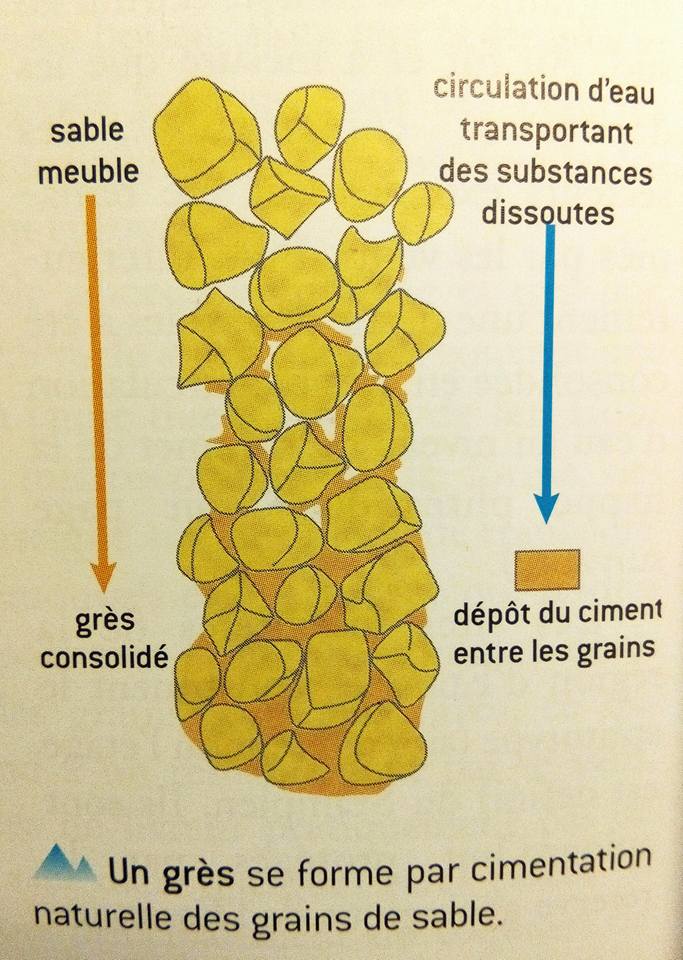Le Grès calcaire de ETHE Croix Rouge

Ce lieu est bien connu par les habitants de la région surtout pour sa légende, mais cette fois, concentrons nous sur sa géologie.
Je vous conseille de vous garer sur le parking indiqué afin de mieux vous imprégniez du biotope particulier de cet endroit.
Jusqu'à la earth
Tout au long du chemin, vous y verrez des pins sylvestres de la zone avec la forêt feuillue environnante.. Le fragment forestier dans lequel il se trouve est composé d'une chênaie à luzule. La végétation y est plutôt acidophile : myrtille, bourdaine, fougère aigle, bouleau verruqueux, sorbier des oiseleurs, germandrée scorodoine, muguet, mélampyre des prés , canche flexueuse et callune. La callune, ou fausse bruyère, à un calice en grelot de couleur rose cachant la corolle minuscule alors que les vraies bruyères (Erica) ont une corolle rose ou rouge et un calice vert.

La earthcache
L’endroit où se trouve le trou des fées se situe sur une couche de grès du SINEMURIEN (Le Sinémurien est un étage du Jurassique inférieur). Ce surplomb rocheux est composé de grès fortement érodé et perforé par de nombreuses cavités. Des galeries se sont creusées par l’érosion naturelle à l’ère jurassique, lorsque la mer occupait encore le Bassin Parissien.

Le grès sinémurien est une roche dure, de couleur jaune constituée par au moins 33% de sable silicieux aggloméré par un ciment calcaire.
La cimentation des grains se fait par précipitation et cristallisation des sels dissous dans l’eau interstitielle. On appelle ce processus la « grésification ».
Pour pouvoir valider cette earthcache, vous devrez répondre aux questions suivantes :
1) Expliquez comment se forme le grès
2) Que se passe t’il si vous grattez cette roche ? Expliquez ce qu’il se passe.
3) Sur quel type de sol, vous trouvez vous?
4) Au WP2, qu’est ce qui se trouve à l’emplacement hachuré de la photo ? ( a gauche des entrées des galleries)

Une photo de vous devant le rocher est la bienvenue mais n'est pas obligatoire.
Loguez cette cache "Found it", ensuite, envoyez moi vos réponses via mon adresse email ou via mon profil via la messagerie du site géocaching.

The calcareous Stoneware of Red ETHE cross:
This place is well known by the inhabitants of the region especially for its legend, but this time, let us concentrate we on his geology.
I advise you to park on the parking lot indicated to better you soaked with the particular biotope of this place.
Throughout the way, you will see fir-trees of the zone with the surrounding leafy forest there.. The forest fragment in which it is consists of an oak grove in luzule. The vegetation is there rather acidophilic: blueberry, bourdaine, fern eagle, birch verruqueux, mountain-ash, germandrée scorodoine, lily of the valley, mélampyre meadows, canche flexueuse and callune. The callune, or false heather, in a chalice in little spherical bell of pink color hiding the tiny corolla while the real heathers.
The eartcache
The place where is the hole of the fairies is situated on a coatof stoneware of the SINEMURIEN (Sinémurien is a floor of the lower Jurassic). This rocky overhang consists of stoneware strongly affected and drilled by numerous cavities. Galleries got dug(grew bigger) by the natural erosion in the Jurassic era, when the sea still occupied the Pond Parissien.
 The sinémurien stoneware is a hard rock, of yellow color established(constituted) by at least 33 % of sand silicieux agglomerated by a calcareous cement.
The sinémurien stoneware is a hard rock, of yellow color established(constituted) by at least 33 % of sand silicieux agglomerated by a calcareous cement.
The cementation of grains is made by haste and crystallization of salts dissolved in the interstitial water. We call this process the "grésification".
To be able to validate this earthcache, you will have to answer the following questions:
1) Explain how forms the stoneware 2) That is you there if you scratch this rock? Explain what it takes place.
3) On what type of ground, you find you?
4) In the WP2, what is in the location hatched of the photo?

It would also be great if you could take a selfie in front of the rock.
Log in this “earthcache” "Found it", then, send me your answers via my email address or via my profile
May I ask each of you to respect this place by not taking anything away? Thank you.